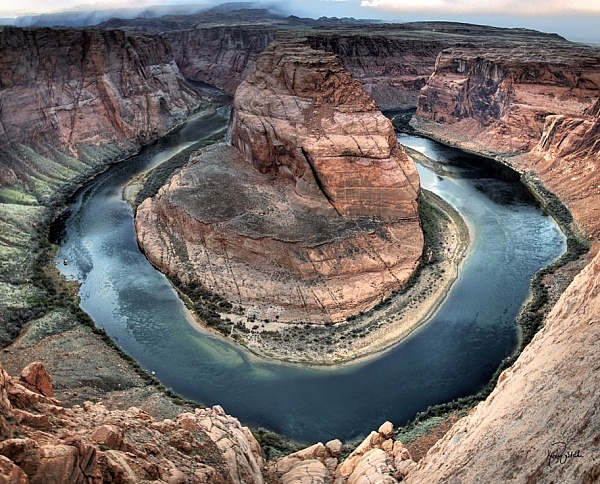Horseshoe Bend: Entrenched Meander of the Colorado River
Horseshoe Bend, and its neighbor Antelope Canyon, are two of the most famous and most-visited features in all of Arizona/Utah. Located near the town of Page, Arizona, Lake Powell, and Glen Canyon Canyon, Horseshoe Bend is a spectacular vista into what geologists call an “entrenched meander”. In short, Horseshoe Bend is a geologic feature where the river curves in a highly exagerated fashion; one mile in a straight line is equal to nearly three river miles. Hiking and exploring Horseshoe Bend is a very popular activity near Page and Lake Powell.
Check out The Goat’s Blog for info, tips, and tricks on hiking Horseshoe Bend and Antelope Canyon

Horseshoe Bend Hiking Information
Distance: Less than a mile. The Navajo Trive has made several “improvements” to the Horseshoe Bend area to accommodate increased visitation. There is a maintained footpath all the way to the overlook.
Difficulty: Very Easy, not really a “hike” in the conventional sense
Best Season to Hike: Given the very short and simple nature of the path, this can be attempted even on the hottest days in the summer. However, spring and fall are the optimal times of the season to visit Horseshoe Bend and the Glen Canyon region.
Permits/Gear: There is no permit required to see Horseshoe Bend. However, there are parking/entrance fee of $10/vehicle. There is no special gear required, and no guide required.
What’s the Deal?: Horseshoe Bend, and its neighbor Antelope Canyon, are two of the most-visited natural attractions in Arizona/Utah. Photos of them grace screensavers, backgrounds, postcards, and social media selfies the world over. Antelope Canyon requires a guide and permit (do not test this, you will get burned), while Horseshoe Bend requires a simple fee.
The Navajo Tribe, in an effort to capitilize on the popularity of Horseshoe Bend while attempting to maintain its integrity, has constructed a large parking lot, restrooms, ramadas with picnic tables, a maintained footpath, and overlook railings. This is a stroll-up photo overlook, and not a hike by any measure. As such, it is often very crowded at all times of the day and all seasons. Do not come here seeking solitude or silence, you will find neither.
Horsehoe Bend is what is known as an entrenched meander in geomorphologic terms. Carved into the Navajo Sandstone and Kayenta Formation, Horseshoe Bend is a spectacular glimpse into how a river functions in relation to the land it flows upon. In this case, the speed of the tectonic uplift of the surrounding area outpaced the erosion by the river.
As the land uplifted, the river was given no choice but to carve deeper down into its existing path. Sheer canyon walls rose abruptly around it, trapping the river in what was to become its canyon. Horseshoe Bend is one of the best examples of river geomorphorphology on the Colorado Plateau.
More Information: Call our office at 602-904-2536 for information regarding guides and hiking to Horshoe Bend and Antelope Canyon.
How to Get There: From Page, Arizona, take HWY 89A east from town. Look for the signs designating the turnoff to Horseshoe Bend. Park and pay the fee.
Ready for an Adventure?
Join Blue Marble Adventure GeoTourism on geology-themed hiking and backpacking adventures! Find the perfect Grand Canyon hiking tour, Utah Canyon Country Tour, Vermillion Cliffs Backpacking or hiking.
